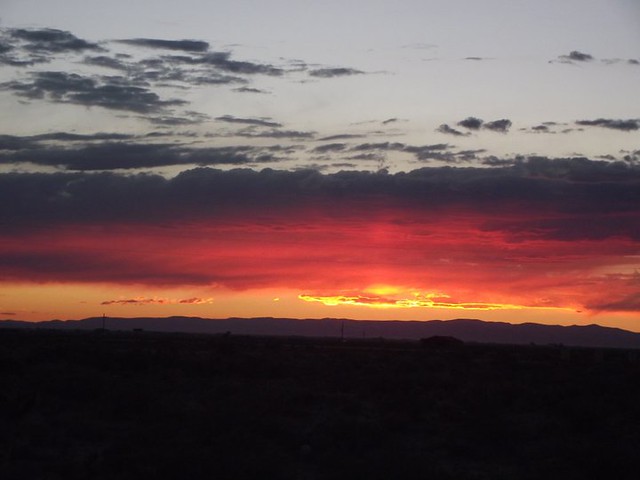While driving from Denver to Albuquerque, I stopped in San Luis De La Culebra, Colorado just north of Questa, New Mexico to visit Colorado's newest Catholic Shrine - La Mesa de la Piedad y de la Misercordia (Hill of Piety and Mercy). The shrine's two centerpieces are The Stations of The Cross and La Capilla de Todos Los Santos (The Chapel of All Saints) . The Stations of The Cross are 15 bronze sculptures, depicting the Passion, Death and Resurrection of Jesus Christ, winding up the Hill of Piety and Mercy to the adobe Chapel of All Saints. Each station is strategically placed along a 3/4 mile ascending trail to look out over the San Luis Valley and to the Sangre de Cristo Mountain range. The stations were sculpted by a local artist Huberto Maestas in 1986. The Chapel of All Saints is a domed adobe structure resting atop the Hill of Piety and Mercy and visible across the San Luis Valley. Local architects, Arnold Valdez and Milton Bertin designed and supervised the construction of this elegant Spanish - Moorish styled church. Catholic families from the Sangre de Cristo Parish of San Luis, many of whom trace their ancestry to the original Spanish settlers who farmed and ranched the San Luis Valley by right of a land grant from Spain, donated the building fund for the Shrine.
The Stations of the Cross are by themselves well worth the visit to San Luis, Colorado. Huberto Maestas's statues embrace drama and emotion and capture the sense of movement up the Hill of Piety and Mercy - a San Luis version of Golgotha. The statues are 2/3 life size with the exception of the life size Crucifixion and Resurrection near the top of the mesa. Each statue is meticulously detailed, down to the folds of clothing, and the sharp thorns protruding from the crown of thorns Jesus wore. Most memorable are the expressions on the faces of Jesus, His mother Mary, His followers and tormentors. In successive stations, Jesus' face reveals sorrow, suffering, resolve and compassion. On the last station, the image of the Resurrection, Jesus' face glows with rapture as he points upwards to Heaven. Each station is positioned next to a large bronze plaque, anchored in concrete, bearing the name of the station and the corresponding Bible verses in both Spanish and English. Benches allow the visitor to rest and meditate on the impact of each station. On Friday afternoons during Lent, the priest from the Sangre de Cristo Parish leads parishioners as well as visitors in The Stations of The Cross by walking the Hill of Piety and Mercy. On Good Friday most of San Luis's residents turn out for a procession up the path of The Stations of the Cross and on Easter Sunday, a Lenten veil is removed from the 15th Station to celebrate Christ's Resurrection.
La Capilla de Todos Los Santos ( The Chapel of All Saints) perches atop The Hill of Piety and Mercy and can be seen across the San Luis Valley, conveying a certain Catholic religiosity to this agricultural setting. The Chapel was finished and dedicated in 1997. The Spanish-Moorish architecture suggests an antiquity belying its real age. The walls are thick adobe and whitewashed. Two steeples and a dome afford elegant balance to the building's exterior. The interior of the chapel is remarkable for its simplicity. The wood pews were hand carved and the aisle rug was hand woven by local artisans. On the afternoon I visited, sunlight streamed in thru the porthole windows on the apse wall. An Icon of the Madonna and her Child adorned the south wall. A hand carved Crucifix and Retablos graced the sacristy. The Chapel of All Saints conveyed sacred solitude and peace, commensurate to its location on a hilltop above the Stations of the Cross Shrine.
I left the town of San Luis in the evening and drove south down the length of the San Luis Valley to the New Mexico border. The sun was descending over the mountains in the west. It was one of those classic Sangre De Cristo sunsets - rose red then dark red. It reminded me of Willa Cather's description of the Sangre De Cristo Mountains, "those red hills, never become vermilion, but a more and more intense rose carnelian, not the colors of living blood, but the color of the dried blood of saints and martyrs." Indeed the Franciscan Padres initially traversed these mountains and valleys in the late sixteenth century, bringing Christianity to the Native American tribes. Most were martyred for their efforts. A second wave of Franciscan Padres came up the Camino Real in the 17th century and brought Spanish settlers with them. The legacy of those early Franciscan missionaries is evident in the Catholic religious symbolism that is integral to life in the San Luis Valley. The Shrine of The Stations of The Cross is one of those symbols. It is a place where the Christian faith is still prominent, where Christian and other religious pilgrims are welcome to visit.
Watch a video of the San Luis Shrine by clicking
Local Tourist Colorado - San Luis and Stations of the Cross - YouTube
www.youtube.com/watch?v=B1zqm-C0T_Q
www.youtube.com/watch?v=B1zqm-C0T_Q




No comments:
Post a Comment